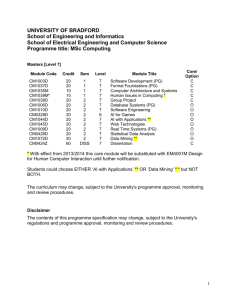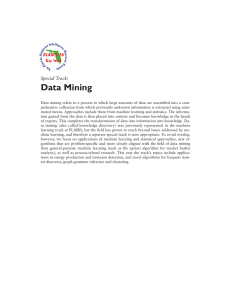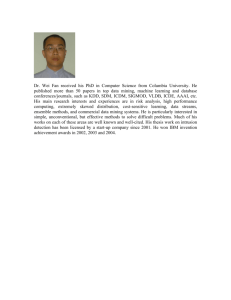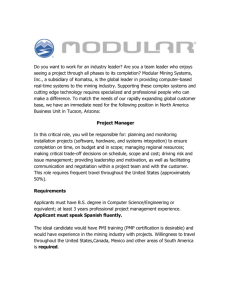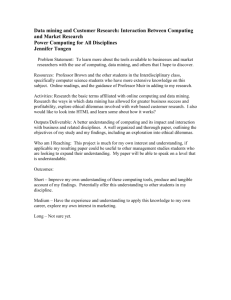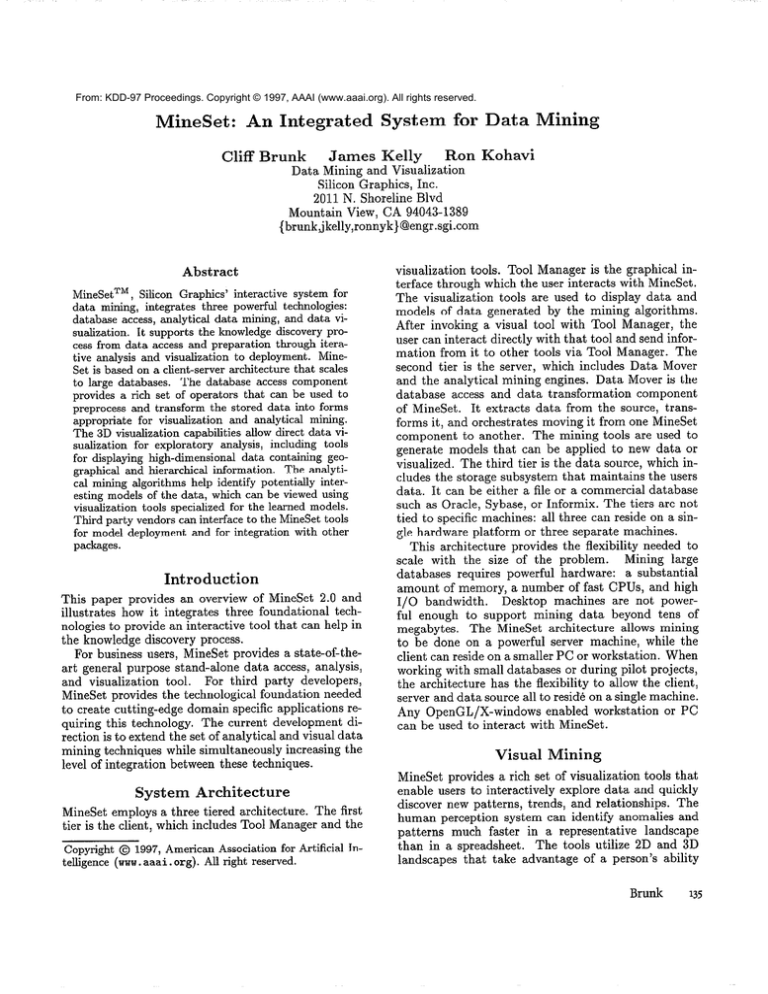
From: KDD-97 Proceedings. Copyright © 1997, AAAI (www.aaai.org). All rights reserved.
MineSet:
An Integrated System for Data Mining
Cliff Brunk
James Kelly
Ron Kohavi
Data Mining and Visualization
Silicon Graphics, Inc.
2011 N. Shoreline Blvd
Mountain View, CA 94043-1389
{brunk,jkelly,ronnyk}@engr.sgi.com
Abstract
MineSetTM , Silicon Graphics’ interactive system for
data mining, integrates three powerful technologies:
database access, analytical data mining, and data visualization. It supports the knowledge discovery process from data access and preparation through iterative analysis and visualization to deployment. MineSet is based on a client-server architecture that scales
to large databases. The database access component
provides a rich set of operators that can be used to
preprocess and transform the stored data into forms
appropriate for visualization and analytical mining.
The 3D visualization capabilities allow direct data visualization for exploratory analysis, including tools
for displaying high-dimensional data containing geographical and hierarchical information. The analytical mining algorithms help identify potentially interesting models of the data, which can be viewed using
visualization tools specialized for the learned models.
Third party vendors can interface to the MineSet tools
for model deployment and for integration with other
packages.
Introduction
This paper provides an overview of MineSet 2.0 and
illustrates how it integrates three foundational technologies to provide an interactive tool that can help in
the knowledge discovery process.
For business users, MineSet provides a state-of-theart general purpose stand-alone data access, analysis,
and visualization tool.
For third party developers,
MineSet provides the technological foundation needed
to create cutting-edge domain specific applications requiring this technology. The current development direction is to extend the set of analytical and visual data
mining techniques while simultaneously increasing the
level of integration between these techniques.
System Architecture
MineSet employs a three tiered architecture. The first
tier is the client, which includes Tool Manager and the
Copyright @ 1997,American Association for Artificial Intelligence (www
. aaai. org). All right reserved.
visualization tools. Tool Manager is the graphical interface through which the user interacts with MineSet.
The visualization tools are used to display data and
models of data generated by the mining algorithms.
After invoking a visual tool with Tool Manager, the
user can interact directly with that tool and send information from it to other tools via Tool Manager. The
second tier is the server, which includes Data Mover
and the analytical mining engines. Data Mover is the
database access and data transformation component
of MineSet. It extracts data from the source, transforms it, and orchestrates moving it from one MineSet
component to another. The mining tools are used to
generate models that can be applied to new data or
visualized. The third tier is the data source, which includes the storage subsystem that maintains the users
data. It can be either a file or a commercial database
such as Oracle, Sybase, or Informix. The tiers are not
tied to specific machines: all three can reside on a single hardware platform or three separate machines.
This architecture provides the flexibility needed to
scale with the size of the problem.
Mining large
databases requires powerful hardware: a substantial
amount of memory, a number of fast CPUs, and high
Desktop machines are not powerI/O bandwidth.
ful enough to support mining data beyond tens of
megabytes.
The MineSet architecture allows mining
to be done on a powerful server machine, while the
client can reside on a smaller PC or workstation. When
working with small databases or during pilot projects,
the architecture has the flexibility to allow the client,
server and data source all to reside on a single machine.
Any OpenGL/X-windows enabled workstation or PC
can be used to interact with MineSet.
Visual Mining
MineSet provides a rich set of visualization tools that
enable users to interactively explore data and quickly
discover new patterns, trends, and relationships. The
human perception system can identify anomalies and
patterns much faster in a representative landscape
than in a spreadsheet.
The tools utilize 2D and 3D
landscapes that take advantage of a person’s ability
Brunk
135
to navigate
in space, track movement,
and compare
objects of different sizes, colors, and shapes. In addition to visualization
and navigation,
the tools contain
sophisticated
filtering and search facilities that allow
users to quickly reduce the landscape to items of interest.
The Statistics
Visualizer displays basic statistics in
histograms
and boxplots. The Scatter Visualizer (Figure 1 left) displays scatterplots
with up to eight dimensions: three axes, entity color, entity size, entity rotation, and two independent
attributes
shown through
animation.
The Splat Visualizer
extends the scatterplots when there are tens of thousands
of records; it
blurs the points using Gaussian smoothing.
The Map
Visualizer
(Figure 1 right) displays data with a spatial component;
a polygonal
map must be provided
and two attributes
can be mapped to the polygon’s
height and color; multiple
maps may be linked together to show different attributes
for the same spatial
geography.
The Tree Visualizer displays data hierarchically; users can determine
the hierarchy and map
attributes
to a histogram
at each node.
Additional
capabilities
shared by most visual tools include: mapping attributes
to graphical
attributes
(color, height,
shape);
manipulating
the scene using thumb-wheels
and mouse movements
for rotation,
translation,
and
zoom; data slicing and animating
by manpulating
sliders for two additional
independent
variables as shown
in Figure 1 (left); drilling-down
by pointing
to elements in the scene; and searching
and filtering the
data. These capabilities
allow users to visualize large
high-dimensional
databases
without
the information
overload usually associated with such tasks.
In this section we breifly described the visual tools
that can be used independently
of the analytical
mining algorithms.
The next section describes the analytical mining tools, and the subsequent
section describes
the specialized visual tools that help users understand
the results of those algorithms.
Analytical
Data Mining Engines
MineSet provides a suite of analytical
mining tools
based on proven algorithms,
such as classifier inducers
generators
(Srikand &
(Mitchell 1997) an d association
Agrawal 1995). The classifiers include decision trees
similar to C4.5 (Q uin 1an 1993)) Simple/Naive-Bayes
(Duda & Hart 1973; Domingos & Pazzani 1996) with
wrapper-style
feature selection (Kohavi & John to apoption decision trees (Kohavi & Kunz
pear), and
1997). Holdout and cross-validation
can be used to estimate the future prediction accuracy of classifiers. MineSet provides reasonable default settings for all mining algorithms making them easy to use, while allowing
experienced
users to optimize the standard
defaults.
MineSet’s analytical
mining components
are based
Sommerfield,
& Dougherty
on MU++
(Kohavi,
1996), the Maching Learning library in C++. MCC++
source code is freely available for research purposes,
136
KDD-97
providing
openness
and promoting
data mining
research.
In addition to promoting
research, having an
open mining
architecture
offers MineSet
a strategic
advantage
because
novel research
ideas developed
within the MLC++ framework
can be easily integrated into future releases of MineSet.
This openness
also allows for easy model deployment,
as nothing is
hidden about the mining algorithms
and nothing
is
proprietary
about the generated models.
MineSet also uses the underlying
Machine Learning
and Statistics
technology
to aid users in other operations of the KDD process.
The two most important
examples are automatic
binning
(discretization)
and
feature selection.
Automatic
binning
creates bins of
(possibly) unequal width based on entropy minimization. For example, binning age with respect to salary
for the UC1 census file yields thresholds of 21, 23, 24,
27, 30, 35, 41, 54, 61, 67. Note how bin ranges are
unequal,
with four small intervals
between the ages
20 and 30, and bigger ranges above 30. Automatic
attribute
selection aids users in finding the relevant
attributes
for their task. MineSet identifies the important attributes
using conditional
entropy minimization
based on oblivious decision trees (Kohavi & Li 1995).
Thus, when a user needs to select the axes for a scatterplot in order to understand
a given factor, he or she
can ask the system to recommend some attributes
that
are important
for explaining
that factor.
Visualizing
Models
Each analytical mining algorithm in MineSet is coupled
with a visualization
tool that aids users in understanding the learned models. Combining
analytical
mining
tools with visual mining provides added value over that
provided by each component
alone. The decision tree
classifier induced can be displayed using the Tree Visualizer. The simple Bayes model can be displayed and
manipulated
using the Evidence Visualizer.
A similar
visualization
tool exists for viewing association
rules.
The visual tools do not simply display the model;
they provide facilities for searching, sorting, filtering,
and drilling down, so that complex models can be
viewed at several levels of detail.
The Evidence Visualizer (Figure 2) shows a simple-Bayes
model. The
real power of the visualizer comes from its ability to
support
“what if” analysis.
By selecting pies corresponding
to known values (or ranges) for attributes,
users can see the affect they have on the predictions
made by this classification
model. The Decision Tree
Visualizer (Figure 3 left) shows a decision tree. Users
can navigate over the decision tree using a fly-through
paradigm.
As they fly to specific areas of the tree,
those subtree
are dynamically
expanded:
nodes are
moved apart to make room for more detail and additional levels are introduced
into the scene. The Rule
Visualizer
(Figure 3 right) shows a set of association
rules.
Figure 1: Left: A Scatterplot for 10 insurance companies and their policy sales. The cube size represents the total revenue.
The upper right portion shows a 2D density plot for the two independent attributes for data slicing. The center right portion
shows the VCR controls for animations. Right: A map of the US with height representing the US population in 1990.
Figure 2: An Evidence Visualizer view for census data on adults working in the US. The pie in the right pane shows the
prior probability distribution for adults making over and under $50,000. The pies in the left pane show each atttribute
and the amount of evidence (pie slice size) each value or range adds to each class label. For example, age is an important
factor for making high salaries, with evidence slightly decreasing for the last pie (over 61 years old). Each pie’s height is
proportional to the number of records in the corresponding value or range.
Figure 3: Left: A Tree Visualizer view for the iris dataset; the bars represent the class distribution, the base height represents
the number of records, and the base color ranges from red (impure) to green (pure). Right figure: a Rule Visualizer view of
supermarket items. The height of each bar represents how well the attribute value on the left predicts the attribute value
on the right. The disks represent the probability of the right side alone. The colors represent the frequency of both the left
hand side and the right hand side occuring together.
Brunk
137
Managing the KDD Process
In addition to visualization
and analytical
mining, MineSet supports
the broader knowledge discovery process (Fayyad, Piatetsky-Shapiro,
& Smyth 1996). This
section focuses on the role that Tool Manager and Data
Mover play in helping execute and manage this process.
Tool Manager provides a consistent
graphical interface to all of the tools. Selecting data sources, specifying data transformations,
setting visualization
and
mining parameters
are all done via a point-and-click
interface.
The Tool Manager also provides a graphic
history for managing
all the operations
performed by
the user and allows updating them in the future. While
many data mining systems focus primarily
on either
the analytic tools or the visual tools, MineSet combines
state-of-the-art
analytic and visual tools with extensive
data transformation
capabilities.
The key data transformation
facilities in MineSet are
binning,
aggregation,
transposition,
and expressions.
These are specified in Tool Manager and executed by
Data Mover on the server, in accordance with the architectural
philosophy that CPU and I/O intensive operations should be done on a fast machine.
Binning translates
from raw data values to bins. MineSet provides a rich interface for binning linear attributes types.
Aggregation
enables data to be summarized
based
on various groups that exist in the data. For example,
it may be useful to summarize
the data from a transaction database by summing purchases, thus giving a
total purchase amount for each customer.
In addition
to summing,
MineSet supports minimum,
maximum,
and average aggregation
operations.
Transpose creates
new attributes
from multiple
records for the same entity, allowing multiple transaction records to be transformed
into a single customer
‘(profile” that is more amenable to mining. For example, if the original data contains transactional
records
with the customer name and product bought, transpose can create one record per customer, containing
a
new attribute
for each possible product bought.
Expressions can be used to define new attributes
using standard
mathematical
expressions and functions.
For example, a total billings attribute
can be defined
as the sum of the billing constituents.
In addition
to the GUI, MineSet
allows submitting mining operations
through
a command
line interface.
This capability
allows developers to provide
users with easy access to predefined
operations
that
can be launched from other applications,
including web
browsers.
Summary
MineSet provides an integrated
analytical
and visual
data mining environment
with an intuitive
graphical
user interface and good defaults for options. It is primarily targeted at business users while providing professional data analysts and system integrators
the abil-
138
KDD-97
ity to fine tune both the analytical
and visualization
tools either through the GUI or command line.
MineSet is built using a scalable client-server
architecture.
The ability to run the visualizations
on a
client for good interactive
performance
while pushing
the intensive computations
needed for the data transformations
and analytical
mining to a server machine
is crucial for mining large databases.
MineSet supports
the knowledge discovery process
from data access and preparation
through
iterative
analysis and visualization
to deployment.
The tight
integration
between the different components
is essential to effective mining and fast, thorough analysis.
Acknowledgments
We would like to thank everyone on the MineSet team and Ross Bott who had the
insight to initiate this project at the time when SGI
was still a hardware-only
company.
References
Domingos,
P., and Pazzani, M. 1996. Beyond independence:
conditions for the optimality
of the simple
Bayesian classifier. In Saitta, L., ed., Machine Learning: Proceedings of the Thirteenth International Conference, 105-112. Morgan Kaufmann.
Duda, R., and Hart, P. 1973.
and Scene Analysis. Wiley.
Pattern
CZassijication
Fayyad, U. M.; Piatetsky-Shapiro,
G.; and Smyth,
P. 1996. From data mining to knowledge discovery:
An overview.
In Advances in Knowledge Discovery
and Data Mining. AAAI Press and the MIT Press.
chapter 1, l-34.
Kohavi, R., and John, G. H. (to appear).
Wrappers
for feature subset selection.
Artificial Intelligence.
Kohavi,
R., and Kunz, C. 1997. Option decision
trees with majority votes. In Fisher, D., ed., Machine
Learning: Proceedings of the Fourteenth International
Conference. Morgan Kaufmann
Publishers,
Inc.
Kohavi,
R., and Li, C.-H.
1995.
Oblivious
decision trees, graphs, and top-down
pruning.
In Mellish, C. S., ed., Proceedings of the 14th International
Joint Conference on Artificial Intelligence,
10711077. Morgan Kaufmann.
Kohavi, R.; Sommerfield,
D.; and Dougherty, J. 1996.
Data mining using MfX++:
A machine learning library in C-I--!-. In Tools with ArtificiaE Intelligence,
234-245. IEEE Computer
Society Press.
http://wwn.sgi.com/Technology/mlc.
Mitchell,
Hill.
T. M.
1997.
Machine Learning.
McGraw-
Quinlan,
J. R. 1993. C4.5: Programs for Machine
Learning. San Mateo, California:
Morgan Kaufmann.
Srikand, R., and Agrawal, R. 1995. Mining generalized association
rules.
In Proceedings of the 21st
International Conference on Ve y Large Databases.

